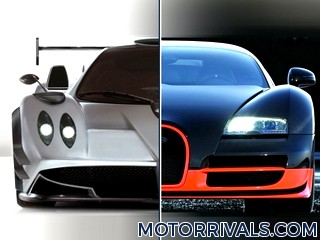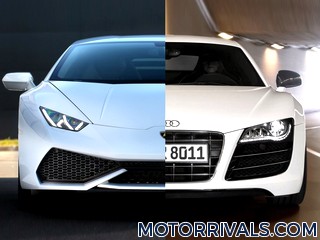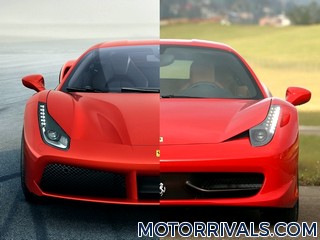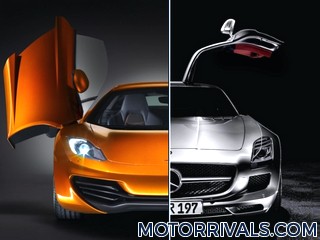2016 Ferrari 488 GTB vs 2016 Lamborghini Huracan LP 610-4
Ferrari 488 GTB Press Release Highlights
The new berlinetta brilliantly encapsulates Ferrari’s
experience in both F1 and the WEC, where the 458 GT holds the World
Championship title and has won its category in the last two editions of
the 24 Hours of Le Mans. The new model also exploits to the full the
know-how gleaned by Ferrari technicians over the last decade through the
XX programme which makes extreme track-only cars available to gentleman
test-drivers. The data yielded has made a significant contribution to
the refinement of the electronic and vehicle control systems so that
drivers can make the most of the incredible performance of this new car.
Powertrain
The Ferrari 488 GTB’s new 3902 cc V8 turbo is at top
of the class for power output, torque and response times, making it the
new benchmark for this kind of architecture. The engine unleashes 670 cv
at 8,000 rpm along with 760 Nm of maximum torque in seventh gear and a
response time to the accelerator of just 0.8 seconds at 2,000 rpm. These
figures are sufficient to allow the 488 GTB to accelerate from 0-200
km/h in an astonishing 8.3 seconds and, when combined with the radical
innovations introduced on all aspects of the car’s performance, lap the
Fiorano track in just 1’23”.
The gearbox features Variable Torque Management which unleashes the engine’s massive torque smoothly and powerfully right across the rev range, while specific gear ratios deliver incredibly progressive acceleration when the driver floors the throttle. As is always the case, engineers have dedicated great attention to perfecting the Ferrari 488 GTB’s sound, creating a new soundtrack that is full, clear and totally distinctive, as expected from any Prancing Horse engine.
Aerodynamics
The car’s aerodynamics
also made a pivotal contribution to performance: its 1.67 efficiency
figure is a new record for a production Ferrari and is the fruit of 50
per cent more downforce than the previous model and reduced drag. The
greatest challenge was achieving these two goals simultaneously. Several
innovative elements were specifically developed to do so, not least a
double front spoiler, base bleed side intakes and, at the rear, active
aerodynamics coupled with a blown spoiler. The aerodynamic underbody,
which incorporates vortex generators, is highly sophisticated, too.
Vehicle dynamics
The Ferrari 488 GTB’s subsystems and electronic
controls make its power and performance instantly available and
controllable. It is, in fact, the most responsive production model there
is, with razor-sharp response times comparable to those of a track car.
The evolved version of Ferrari’s side slip angle control system
(Side Slip Control 2 – SSC2), is more precise and less invasive,
providing greater longitudinal acceleration out of corners. Aside from
integrating with car’s F1-Trac and E-Diff, the SSC2 now also controls
the active dampers which renders the car’s dynamic behaviour during
complex manoeuvres even flatter and more stable.
ENGINE
Type V8
– 90° Turbo
Overall displacement 3902 cm3
Maximum power * 492 kW
(670 CV) at 8000 rpm
Maximum torque * 760 Nm at 3000 rpm in VII gear
DIMENSIONS AND WEIGHT
Length 4568 mm
Width 1952 mm
Height
1213 mm
Dry weight** 1370 kg
Weight distribution 41.5% Front –
58.5% Rear
PERFORMANCE
0-60 mph 3.0 s (estimated)
0 -124
mph 8.3 s (estimated)
Maximum speed > 205 mph
FUEL CONSUMPTION***
20.6 mpg (estimated)
Lamborghini Press Release Highlights
With the Huracán LP 610-4, Lamborghini is taking its purist, unmistakable design language to a whole new evolutionary level. The design is bold and edgy, with beautifully sculptural forms. The starting point of the design process was the Huracán's silhouette. The objective was to define the car with a single line stretching from the front end over the passenger cell to the rear. The side windows take on a hexagonal form that looks like a gem set into the profile of the Huracán. At night, too, it is utterly unmistakable: All lights, including the main headlamps, beam in LED technology - an absolute first in the super sports car segment.
An innovative cockpit dominates the interior. The 12.3-inch TFT display can be configured in a number of different modes and provides the driver with all key information in a virtual format. The slender lines of the instrument mounts and the center tunnel are indicative of the lightness of the interior design. Fine materials distinguish the interior, which can be extensively individualized, while the extremely detailed craftsmanship delivers a highly refined sense of quality.
The newly conceived hybrid chassis of the Huracán LP 610-4 is a technical work of art that unites carbon-fiber and aluminum components. The ultralight chassis forms the basis for the vehicle’s low dry weight of 1,422 kilograms; with its excellent stiffness, it guarantees the handling precision of a racing car.
The new V10 engine in the Huracán generates its phenomenal propulsion from a displacement of 5.2 liters. It produces a power output of 448 kW / 610 hp at 8,250 rpm and a maximum torque of 560 Nm at 6,500 rpm. The new "Iniezione Diretta Stratificata" combines direct and indirect injection - achieving an increase in power and torque compared with the Gallardo and a decrease in fuel consumption and emissions.
With its power-to-weight ratio of just 2.33 kilograms per hp, the Lamborghini Huracán achieves absolutely breathtaking performance. The top speed of more than 325 km/h and the acceleration figures - zero to 100 km/h in 3.2 seconds, zero to 200 km/h in 9.9 seconds – offer an indication of its dynamics. Thanks in part to the Stop & Start technology, ECE average fuel consumption has dropped to 12.5 liters per 100 km (290 g CO2 per km).
The power generated by the ten-cylinder is delivered to the road via the new 7-speed dual-clutch transmission "Lamborghini Doppia Frizione" (LDF) and an all-wheel drive that also features a new hydraulic multi-plate clutch. Three different driving modes, spanning from road to race track, can be selected using a drive select switch in the steering wheel. The system is called ANIMA (Italian for Soul) - "Adaptive Network Intelligent Management", and impacts the engine, the transmission, the all-wheel drive and the ESC handling system as well as other dynamic systems.


















